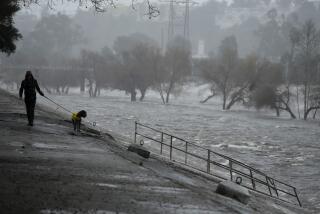Newton: Can Garcetti calm the waters?
After a campaign of smart politics but small ideas, Eric Garcetti is poised to take the office that he won last month. As he does, here’s an item worthy of his agenda: Make peace with the Owens Valley.
Residents of the Owens Valley rely heavily on Los Angeles; some even live in houses that they lease from the city’s Department of Water and Power, by far the largest landowner in the picturesque towns of the Eastern Sierra. And yet, many residents are understandably resentful of Los Angeles. They can’t vote in the city’s elections, and they hold little sway with the agencies that have, for 100 years, siphoned off the water from the Owens River and carried it away. In many ways, the Owens Valley today is a colony of Los Angeles.
Los Angeles owes a debt to the people of the Eastern Sierra. Having secured a stable water supply, the city was able to launch the growth that would make it the modern metropolis it is today. And having lost that water, the Owens Valley missed its chance to be a fertile farmland along the lines of the Imperial or San Joaquin valleys.
The battle over water rights was fought long ago, and Los Angeles decisively won it. There is, however, an unfinished piece of business — and a source of continuing conflict — from that era. By diverting water from the valley, Los Angeles contributed to the disappearance of Owens Lake. Today, the dry lake bed sends up fine salts and dust every time the wind blows hard. Those fine particles are a risk to the health of valley residents.
Los Angeles has a responsibility to control that dust. Ted Schade (it’s pronounced “shady”), the air pollution control officer for the Great Basin Unified Air Pollution District, compares the dust to the smoke emitted by a coal-fired factory. “The Owens Valley is the city of Los Angeles’ water factory,” Schade told me last week as we toured the old lake bed. “The Owens Lake is the smokestack.”
But what is the appropriate extent of Los Angeles’ obligation to the Owens Valley? Today, the city is controlling dust on the lake bed by diverting more than 70,000 acre-feet of water every year (the city fears that the amount needed could eventually reach as much as 95,000 acre-feet, roughly as much as the entire city of San Francisco consumes each year).
Moreover, Los Angeles is not alone in drying up the Owens Lake. Even before the city commandeered the Owens River, farmers in the area were siphoning off water. And though Los Angeles has a legal and moral responsibility to bring the lake bed into compliance with federal particulate standards, it can’t be held responsible for making the Owens Valley dust-free. It is, and always was, a dusty place.
Happily, there are solutions. Tamping down dust on the lake does not require flooding it. Gravel would be a more permanent fix that requires no water. Shallow flooding, along with planting grasses, is an intermediate option, requiring some water, but not much, and some maintenance — but, again, not much.
The struggle to control dust in the Owens Valley has been a frustrating experience for all concerned. After initially working cooperatively with the district, the DWP has recently balked, complaining that even after investing more than $1 billion in cleaning up the lake, the demands continue.
Having already controlled dust on 45 square miles, the DWP is now refusing to complete an additional 31/2 or so square miles that Schade estimates would complete the job. The two sides have been in court regularly, with the air pollution district consistently prevailing.
Still, there are the makings of a deal: Los Angeles should finish the required mitigation, and Schade should give the city time and latitude to do so efficiently. The city could save water; the valley could lose dust. I asked Schade whether he could imagine a future in which the city used significantly less water to mitigate the dust and the valley’s air still was protected. His answer: “Absolutely.”
Here’s where Garcetti could come in. The two sides are furious with each other and are burning through legal fees. But Garcetti is a new player, untethered to either side. He’s also proud of his environmental record, and he could use a big issue or two to define his mayoralty.
There’s even an auspicious date to aim for. It was Nov. 5, 1913, when William Mulholland famously opened the Los Angeles Aqueduct with one of history’s great speeches. “There it is,” Mulholland said as the water gushed. “Take it.” That water ensured Los Angeles’ future but commenced 100 years of conflict. Five months from now, on the 100th anniversary, Garcetti could bring it to an end.
Jim Newton’s column appears Mondays. His latest book is “Eisenhower: The White House Years.” Reach him at jim.newton@latimes.com or follow him on Twitter: @newton_jim.
More to Read
A cure for the common opinion
Get thought-provoking perspectives with our weekly newsletter.
You may occasionally receive promotional content from the Los Angeles Times.






